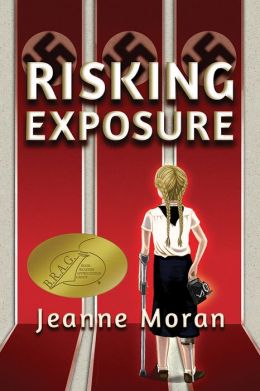Local author Jeanne Moran has just published RISKING EXPOSURE, a novel featuring fourteen-year-old Sophie: amateur photographer and member of Hitler Youth. We asked her what the writing process was like, and she answers below.

I
had published articles and short pieces in national magazines, but before Risking Exposure I had never attempted a
novel-length work. In order to learn how-on-earth-do-I-write-something-that-long,
I took two novel-writing courses a couple years apart. Both helped enormously
at different stages of the novel’s development, teaching me about research,
planning, outlining, and self-editing. But like most things, I didn't really
know how-to until I jumped in feet first and did it, made mistakes, and learned
from them.
I
started jotting down ideas for this novel about six years ago, and originally
planned for it to be part historical fiction, part fantasy. I wrote each
planned scene on an index card, and taped each card in sequence on the long
roll of postal paper which was my storyline. My idea was to take down one index
card, put flesh on that scene through narrative and dialogue, then flip it over
- scene written. Do that a few dozen times, and my novel would be done. Right? Wrong.
By scene 2, my characters felt restricted by the plot. By scene 3, my characters
began to rebel and I'd find a scene was moving in a direction I hadn't
intended. The whole work suddenly became an undisciplined mess, especially the
fantasy elements I’d planned - they just didn’t work at all. By scene 4, my
characters were on strike and my entire novel was stuck. I had to step back and
analyze this train wreck.
By
reading lots of books and articles about the writing process and with the help
of the Writers Group at the Dietrich, I realized the characters had become
pawns in my plotline and weren't living, breathing humans. So I ditched the
structure of index cards and postal paper and sketched out fuller character
arcs. I spent more time planning each character's growth, allowed them room to
breathe, show their own weaknesses and develop their own strengths. Then I
began to write scenes involving character interaction, not worrying about where
exactly the scene would fall in the final product. Somehow, the plot
reorganized itself in a more organic way. The fantasy elements went into a
‘deleted scenes’ folder and the novel became pure historical fiction. I plan to
use those fantasy pieces in another novel, so they won't be wasted.
Stay tuned for more from Jeanne! And, join us here at the library for an Author Talk featuring Jeanne on Tuesday, January 14 at 6:30PM. Please register in December.
No comments:
Post a Comment